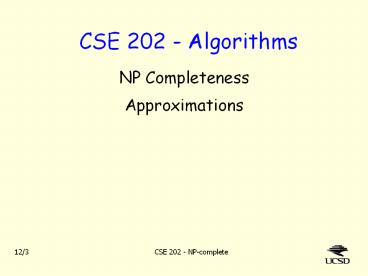CSE 202 - Algorithms - PowerPoint PPT Presentation
Title:
CSE 202 - Algorithms
Description:
CSE 202 - Algorithms NP Completeness Approximations Decision Problems Instance: an input, an output, and a size. Problem: a set of instances. Decision Problem ... – PowerPoint PPT presentation
Number of Views:47
Avg rating:3.0/5.0
Title: CSE 202 - Algorithms
1
CSE 202 - Algorithms
- NP Completeness
- Approximations
2
Decision Problems
- Instance an input, an output, and a size.
- Problem a set of instances.
- Decision Problem Problem where each instances
output is T or F. - Given graph G and nodes x and y, what is the
shortest path from x to y? is not a decision
problem. - Given G, x, y, and k, is there a path from x to
y of length ? k? - Usually, given an algorithm for a decision
problem, one can use it to solve the associated
optimization problem. - E.g., use binary search Is there a path of
length ? 50?, ? 25?, ? 37?, ... .
(You know this already.)
3
Reductions
- Given two decision problems A and B, we say that
a function f from A to B is a reduction of A to B
if, for every instance x in A, x is true if and
only if f(x) is true. - We write A ? B, and say A is reducible to B.
f
f(x)
x
an instance of problem A
instance of B
A
B
T,F
4
Example of reductions
- Weve seen
- how to reduce a maximum matching problem on
bipartite graph to a max flow problem. - how to reduce a general maximum matching problem
to linear programming. - Except for 2 trivial problems, every computable
function is reducible to every other computable
function. - Let bT be a true instance of B bF a false
instance. - Given instance x of problem A, f could figure out
the answer, then return bT if x is true, bF
otherwise. - Mathematicians use reductions to study
uncomputable functions (like the halting
problem).
Always True Always False
5
Polynomial Time Reducibility
- In computer science, we limit how much work f can
do. - Typically, f must be a polynomial-time algorithm.
- We write A ?p B, and say A is polynomial-time
reducible to B or A is no harder than B. - If A ?p B, can we conclude B ?p A ??
- Isnt f-1 is a reduction of B to A?
- (Give two reasons this doesnt work)
- IMPORTANT! To show A ?p B, we must show
- for every instance x of A, how to construct an
instance f(x) of B relatively quickly (i.e. in
polynomial time), and - if f(x) is true, then x is true, and
- if f(x) is false, then x is false.
6
Typical GareyJohnson Style Entry
- Actually from www.csc.liv.ac.uk/ped/teachadmin/C
OMP202/annotated_np.html - Name 3-Dimensional Matching (3DM) SP1 3
- Input
- 3 disjoint sets X, Y, and Z each comprising
exactly n elements - a set M of m triples (xi, yi, zi) 1 ? i ? m
such that xi is in X, yi in Y, and zi in Z, i.e.
M is a subset of X x Y x Z. - Question Does M contain a matching?
- i.e. is there a subset Q of M such that Qn and
for all distinct pairs of triples (u,v,w) and
(x,y,z) in Q, u ? x, v ? y and w ? z. - Comments The variant 2-dimensional matching in
which 2 disjoint sets X and Y form the basis of a
set of pairs, can be solved by a number of fast
methods.
7
Glossary (in case symbols are weird)
- ???????????????? ? ? ? ? ? ? ? ? ?
- ? subset ? element of ? infinity ? empty
set - ? for all ? there exists ? intersection ?
union - ? big theta ? big omega ? summation
- ? gt ? lt ? about equal
- ? not equal ? natural numbers(N)
- ? reals(R) ? rationals(Q) ? integers(Z)































